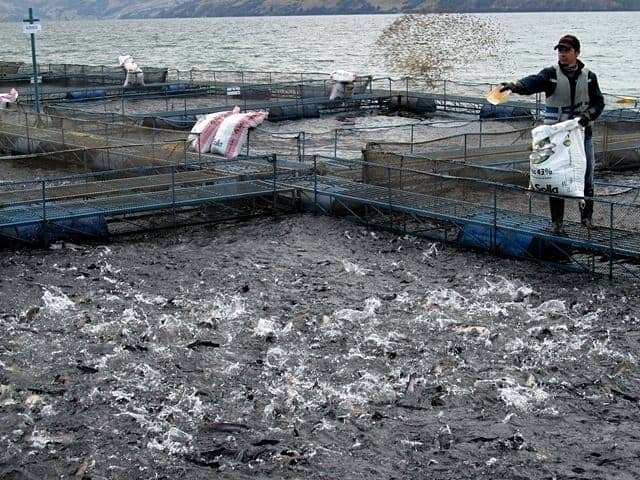
Amoxicillin (AMX) is a widely used antibiotic in aquaculture to treat bacterial diseases in fish. However, knowledge about its pharmacokinetics (PK) and tissue residues in fish has been limited. This can lead to improper use of the drug, which may result in negative consequences for fish health and the environment.
A recent study published in the journal Veterinary Quarterly by researchers from Kasetsart University (Thailand), the Veterinary Research Institute (Taiwan), and National Chung Hsing University (Taiwan) aimed to study the pharmacokinetic characteristics of AMX in Nile tilapia (Oreochromis niloticus) raised at different temperatures (25 and 30 °C). They also established the optimal dosages and withdrawal time (WDT) for AMX in tilapia.
Amoxicillin (AMX)
Amoxicillin (AMX) is a common antibiotic used to treat bacterial diseases in Nile tilapia, an important species in freshwater aquaculture. While its efficacy against streptococcosis, a widespread disease in tilapia, is well established, the responsible use of AMX requires information on the optimal dosage and withdrawal time (WDT) specific to Nile tilapia.
Current Challenges of Amoxicillin Use in Tilapia
- Limited Pharmacokinetic and Pharmacodynamic Data: Data on the pharmacodynamic (PD) aspects of AMX, such as the minimum inhibitory concentration (MIC) against Nile tilapia pathogens, are scarce. Similarly, pharmacokinetic (PK) data, crucial for determining the optimal dosage, are lacking for Nile tilapia raised at different water temperatures.
- Inconsistent WDT Practices: Withdrawal time guidelines for AMX in tilapia vary by region. Some regions lack specific recommendations, forcing fish farmers to rely solely on product labels.
Importance of Pharmacokinetics
Understanding the complete picture of AMX in Nile tilapia, including PK, PD, and WDT, is vital for:
- Effective Treatment: The optimal dosage based on water temperature and bacterial susceptibility ensures effective treatment while minimizing the risk of under- or overdosing.
- Consumer Safety: Establishing an appropriate WDT ensures that AMX residues in fish muscle fall below safe levels for human consumption.
- Antibiotic Management: The judicious use of antibiotics helps combat the growing threat of antibiotic resistance in bacteria.
Temperature-Dependent Elimination and Dosing
The study revealed that the elimination of AMX from the fish’s body depends on water temperature. Higher water temperatures resulted in faster drug elimination. It was also found that the optimal AMX dosage depended on temperature. Fish raised at 30 °C required a higher dose than fish raised at 25 °C to achieve the same therapeutic effect.
Withdrawal Time (WDT)
The study determined the WDT for AMX in tilapia. WDT refers to the time required for antibiotic residues in fish muscle to deplete below the maximum residue limit (MRL). The MRL is the highest legally permitted level of a drug residue in food products. The study found that the WDT for AMX in tilapia was 6 days at 25 °C and 4 days at 30 °C.
Responsible Use of AMX in Aquaculture
These findings provide valuable information for the responsible use of AMX in Nile tilapia aquaculture. By adhering to the proper dosage and WDT, fish farmers can ensure effective treatment of their fish while minimizing the risk of antibiotic residues in the final product.
Below are additional points to consider for the responsible use of AMX in aquaculture:
Stay Always Informed
Join our communities to instantly receive the most important news, reports, and analysis from the aquaculture industry.
- Veterinarian-Diagnosed Treatment: Use AMX only to treat bacterial infections diagnosed by a veterinarian.
- No Prophylactic Use: Avoid using AMX for prophylactic purposes (to prevent diseases).
- Veterinarian-Prescribed Regimen: Follow the recommended dosage and treatment duration as prescribed by a veterinarian.
- Proper Medication Disposal: Properly dispose of unused or expired AMX medications.
Conclusion
By following these guidelines, fish farmers can help ensure the effectiveness of AMX in treating bacterial diseases in fish. This approach helps minimize the risk of antibiotic resistance and environmental contamination, promoting sustainable aquaculture practices.
The study was funded by the Animal and Plant Health Inspection Agency, Ministry of Agriculture, Executive Yuan, Taiwan.
Contact
Chi-Chung Chouc
Department of Veterinary Medicine, College of Veterinary Medicine, National Chung Hsing University
Taichung, Taiwan
Email: ccchou@nchu.edu.tw
Reference (open access)
Rairat, T., Lu, Y. P., Ho, W. C., Ke, H. J., & Chou, C. C. (2024). Pharmacokinetics, optimal dosages and withdrawal time of amoxicillin in Nile tilapia (Oreochromis niloticus) reared at 25 and 30 °C. Veterinary Quarterly, 44(1), 1–9. https://doi.org/10.1080/01652176.2024.2396573
Editor at the digital magazine AquaHoy. He holds a degree in Aquaculture Biology from the National University of Santa (UNS) and a Master’s degree in Science and Innovation Management from the Polytechnic University of Valencia, with postgraduate diplomas in Business Innovation and Innovation Management. He possesses extensive experience in the aquaculture and fisheries sector, having led the Fisheries Innovation Unit of the National Program for Innovation in Fisheries and Aquaculture (PNIPA). He has served as a senior consultant in technology watch, an innovation project formulator and advisor, and a lecturer at UNS. He is a member of the Peruvian College of Biologists and was recognized by the World Aquaculture Society (WAS) in 2016 for his contribution to aquaculture.




